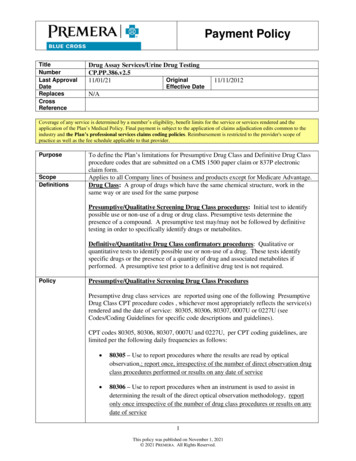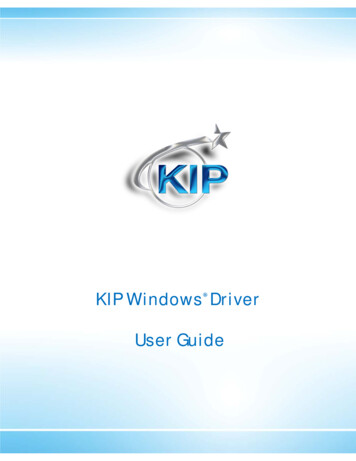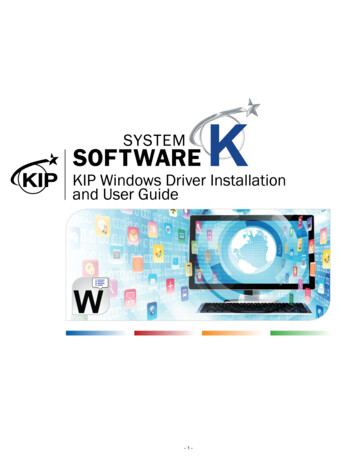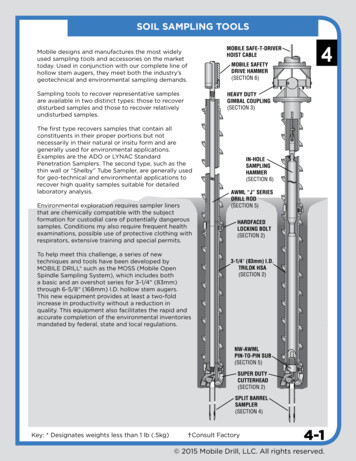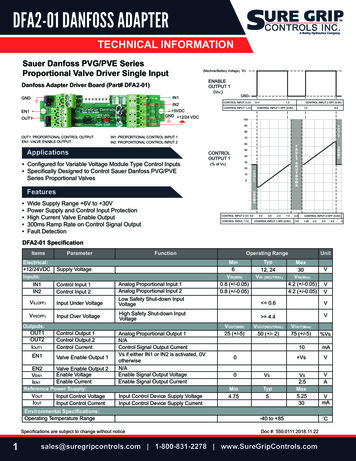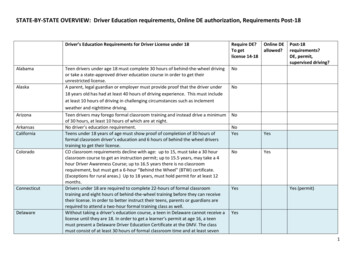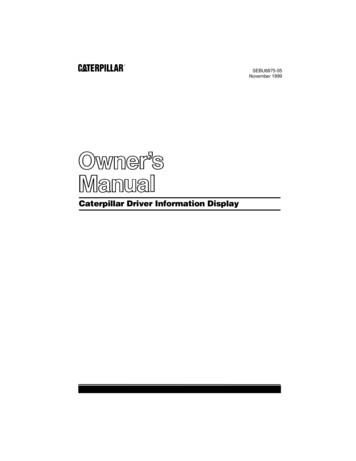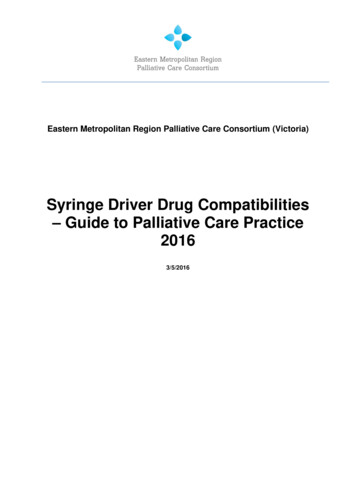
Transcription
Eastern Metropolitan Region Palliative Care Consortium (Victoria)Syringe Driver Drug Compatibilities– Guide to Palliative Care Practice20163/5/2016
INSTRUCTIONS FOR USEIt is highly recommended this guide is used electronically or printed in colour, to aid ease of use.ContentsDISCLAIMER . 3IMPORTANT CONSIDERATIONS . 3KEY . 3Compatibility . 4Infusion site problems . 4Syringe Driver Information . 4Clonazepam . 5Cyclizine . 6Fentanyl . 8Glycopyrronium . 9Haloperidol . 10Hydromorphone . 12Hyoscine Butylbromide (Hyoscine BBr) . 13Ketamine . 14Ketorolac . 15Levomepromazine . 15Lidocaine . 17Methadone . 17Metoclopramide . 17Midazolam . 18Morphine Sulfate . 19Morphine Tartrate . 19Octreotide . 19Olanzapine . 19Ondansetron . 19Oxycodone . 19Phenobarbital . 20Ranitidine . 20Sufentanil . 20REFERENCES . 21Acknowledgements . 21Name used in this documentGlycopyrroniumLidocainePhenobarbitoneFull titleGlycopyrronium bromide (glycopyrrolate)Lidocaine (lignocaine) hydrochloridePhenobarbital (phenobarbitone) sodiumPreviously calledGlycopyrrolateLignocaine hydrochloride anhydrousPhenobarbitone redient-names-list-affected-ingredients 2016. The Eastern Metropolitan Region Palliative Care Consortium (EMRPCC) grants permission to reproduce this publicationfor clinical and educational use, provided that the EMRPCC is acknowledged. Requests to reproduce this document, for purposesother than those stated, should be addressed to:Consortium ManagerEastern Metropolitan Region Palliative Care Consortiumc/- PO Box 2110 Rangeview 3132Victoria, Australiaorconsortiummanager@epc.asn.auPage 2 of 21
DISCLAIMERThe information in this palliative care document is intended as a guide only. It is the responsibility of theuser to ensure information is used correctly. This guide reflects adult palliative care practice in Victoria andis based on evidence at the time of review.All drug compatibility combinations derived from this guide should be checked and prescribed by a medicaldoctor or nurse practitioner with appropriate experience before administering.In accordance with quality practice, this guide should be submitted for organisational approval prior to use.When setting up and using syringe drivers, follow organisational policy and procedures.IMPORTANT CONSIDERATIONS It is recommended that the number of drugs in one syringe be limited to three.Caution should be used when combining drugs in syringe drivers; mixtures should be closelymonitored for discolouration, precipitation and crystallisation. Infusion durations in this guide are for 24 hours. Sodium chloride 0.9% is the diluent used in this guide, except where stated. Subcutaneous administration of a drug may be off-label prescribing Drug doses should be modified in response to the adult patient/client’s clinical situation and status,including previous exposure to opioids and concurrent medications. All patients should bemonitored closely when commencing and/or switching opioid medications.If you require further information regarding drug combinations and compatibility data, contact a hospitalbased pharmacy drug information service working with a specialist palliative care service.KEYInstructions for reading the list of drugsAll drugs are listed in alphabetical order. When searching for drug combinations, search by the drugwhich occurs first alphabetically. Drug combinations are not repeated in reverse orderExample: HaloperidolHaloperidol, HydromorphoneHaloperidol, Hydromorphone, MetoclopramideSymbolExplanationAppears compatible. Information is gathered from the clinical setting based onobservation of the drug combination on mixing and during infusion for any physicalchanges, e.g. precipitation, discolouration or clouding.The information is not validated evidence based research.Compatibility information available based on laboratory dataABCA Chemically Compatible. Compatibility data obtained by laboratory analysis in thestated drug combination, in the usual diluent and over a range of temperatures.B Physically Compatible. The lack of physical change such as discoloration, cloudingor crystallization tested microscopically or by laboratory analysis.C potential for site reaction. See ‘Infusion site problems’ p.4Conflicting information regarding compatibility – proceed with cautionCaution can apply to clinical and evidence based compatibility reportsIncompatibleWFIWater for InjectionEastern Metropolitan Region Palliative Care Consortium – Clinical Group 2016Page 3 of 21
CompatibilityCompatibility is dependent on the concentration of each drug in the total final volume being infused, ratherthan the actual dose.Numerous factors effect stability and compatibility including drug salt, strength, diluents, order of drawing up,temperature and infusion periods. In this guide, infusion durations are for 24 hours.Monitoring of the combined drugs in the syringe driver throughout the infusion period is advised.Sodium chloride 0.9% is the diluent used routinely in Victorian practice, except for cyclizine which isdiluted with Water for Injection.Sodium Chloride 0.9% is used as the diluent throughout this guide, unless otherwise stated.When combining medications for syringe driver use, be aware that laboratory compatibility data is availablefor only a few drug combinations. As a consequence, the majority of combinations listed in this guide areobservational data.If the combination is not listed in this practice guideline, consult1. Dickman A, Schneider J. The Syringe Driver Continuous subcutaneous infusions in palliative care.3rd ed. Oxford: Oxford University Press; 201112. The syringe driver database on the palliative care website www.palliativedrugs.com 2The syringe drive database available at www.palliativedrugs.com can be accessed after registration. Combinationson the database have been assessed by palliativedrugs.com pharmacists. The information is not substantiated but isobservational data. The database may contain information not included in this document. The database states that“drugs may be compatible at certain concentrations and not at others, therefore it is recommended that theconcentration of drug in solution is compared, not the dose” 2Infusion site problemsA plastic (Teflon or Vialon ) cannula should be used rather than a metal butterfly needle to reduce siteinflammation.A skin reaction at the infusion site is most commonly found with cyclizine, ketamine, levomepromazineand methadone.Sodium Chloride 0.9% is recommended as diluent as it is closest to physiological tonicity, therefore less likelyto cause irritation. Cyclizine should always be diluted with Water for Injection. .Subcutaneous sites may last up to a week, depending on the drugs used. The site should be changed ifpainful or inflamed. Routine rotation to a different subcutaneous site every 72 hours reduces the frequencyof site problems. If frequent resiting is necessary, e.g. every 24 to 48 hours, consider the following strategies: Use a larger syringe to enable a more dilute mixture to be used, thereby decreasing the final drugconcentrationsChange to a 12 hourly regimen, thereby permitting further dilution of the drugsChange an irritant drug to a less irritant alternativeInject dexamethasone 1mg directly into the infusion site, via the cannula to be used. Flush with sodiumchloride 0.9% then connect the syringe driver and commence.1Chlorpromazine, diazepam and prochlorperazineThese drugs are not recommended to be given by subcutaneous infusion due to severe local reactions3.Syringe Driver InformationFor further information on the use of syringe drivers see Guidelines for Subcutaneous Infusion DeviceManagement in Palliative Care – second edition 2010 available 3Eastern Metropolitan Region Palliative Care Consortium – Clinical Group 2016Page 4 of 21
Syringe Driver Drug Compatibilities – Guide to Palliative Care Practice 2016DRUGCOMPATIBILITYClonazepamA,BClonazepam, Cyclizine, Morphine SulfateCOMMENTREFERENCEThere is a significant loss when infused through PVC tubing which can beaddressed by using non PVC tubing or titrating the dose to desired effect.1,5WFIDiluent must be water for injection due to cyclizine.Clonazepam, Glycopyrronium, Oxycodone12Haloperidol at concentrations greater than 1mg/mL may precipitate in sodiumchloride 0.9%.1Clonazepam, Haloperidol, Morphine SulfateHaloperidol at concentrations greater than 1mg/mL may precipitate in sodiumchloride 0.9%.2Clonazepam, Haloperidol, Morphine TartrateHaloperidol at concentrations greater than 1mg/mL may precipitate in sodiumchloride 0.9%.1,2Haloperidol at concentrations greater than 1mg/mL may precipitate in sodiumchloride 0.9%.1Clonazepam, Haloperidol, MethadoneCClonazepam, Haloperidol, OxycodoneBClonazepam, Hydromorphone2Clonazepam, Hyoscine Butylbromide2Clonazepam, Hyoscine Butylbromide, Morphine Sulfate1Clonazepam, Hyoscine Butylbromide, OxycodoneClonazepam, Ketamine, Morphine Tartrate1CClonazepam, Ketamine, Oxycodone2CClonazepam, Ketorolac, OxycodoneDilute ketorolac maximally with sodium chloride 0.9%.Clonazepam, Levomepromazine, Methadone1CClona
All drug compatibility combinations derived from this guide should be checked and prescribed by a medical doctor or nurse practitioner with appropriate experience before administering. In accordance with quality practice, this guide should be submitted for organisational approval prior to use. When setting up and using syringe drivers, follow organisational policy and procedures. IMPORTANT .
